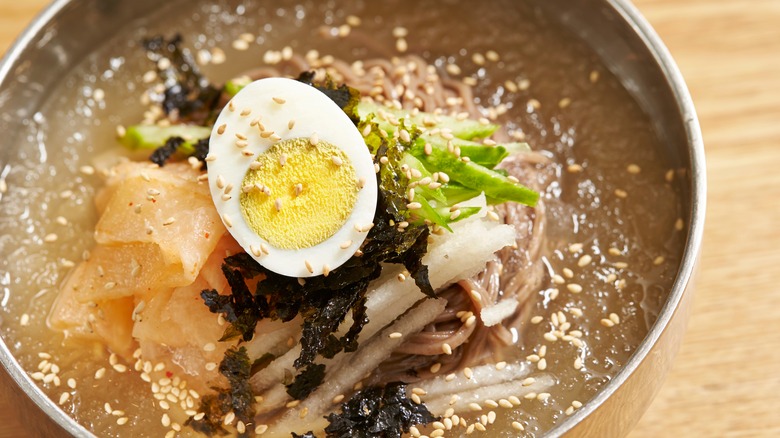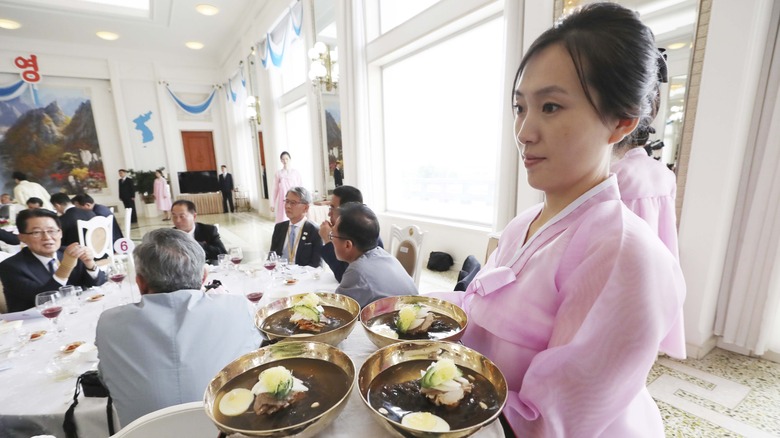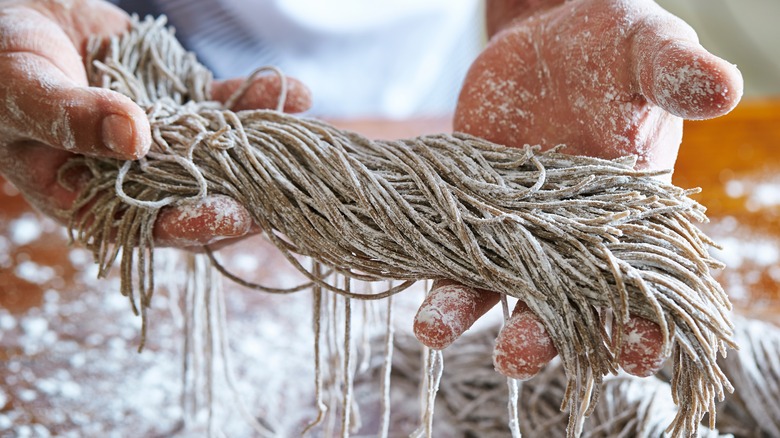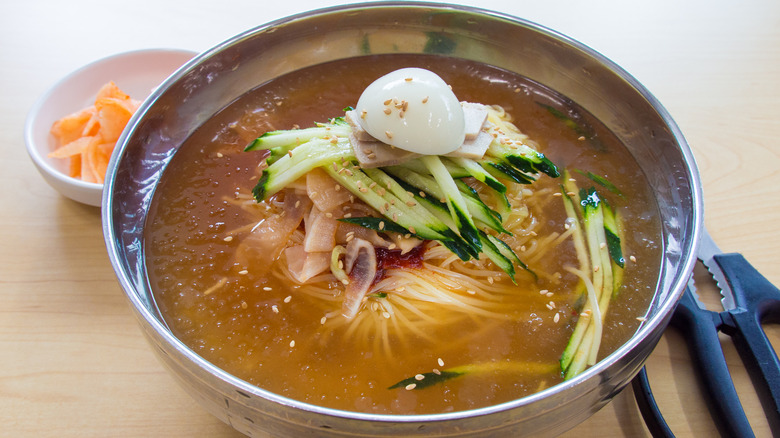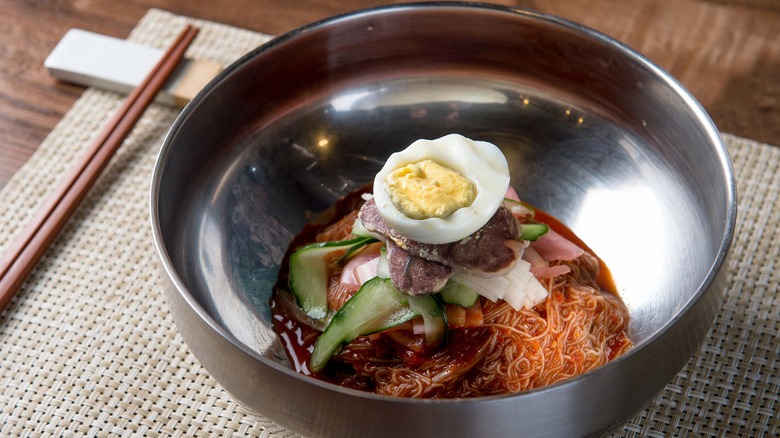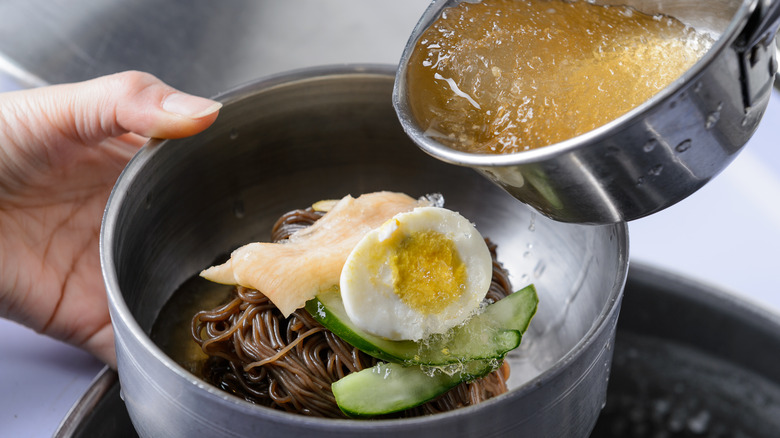Mul Naengmyeon: The Korean Noodle Soup That's Ideal For Hot Weather
"Cold noodles" is a phrase that evokes different dishes for different diners. Maybe you think of your favorite summer picnic pasta salad recipe or an Asian-inspired dish with crunchy vegetables that you love to douse in peanut sauce. One especially unique cold noodle dish goes beyond the threshold of refrigerated pasta: It's so cold that it has ice in it. It's called mul naengmyeon, and it satisfies a craving for the cold crunch of a slushie, while also pleasing your palate with savory flavors. Thin and chewy buckwheat noodles bathed in an icy beef broth and topped with fresh cucumber and hard-boiled egg, mul naengmyeon is a Korean summer classic.
Hailing from North Korea, this dish holds a special place for Koreans throughout the country, with its rich history and the multiplicity of its styles. Mul naengmyeon directly translates to water cold noodles, and it is exactly that: intensely elastic noodles in a shockingly cold broth. It is like nothing you've ever had, and you'll find yourself rejuvenated by its sweet, vinegary flavor profile.
Where is mul naengmyeon from?
Naengmyeon, or cold noodles, are said to have first been mentioned during the Joseon dynasty in a book called "Gyegokjib" by Jang Yu. As shown in the Netflix documentary on naengmyeon, "Korean Cold Noodle Rhapsody," what we know of mul naengmyeon today originated from Pyongyang, the capital of North Korea. Pyongyang-style naengmyeon is the country's most popular dish to this day.
Once the Korean War broke out, many Northerners escaped conflict and moved toward the south, bringing with them the flavors of the original Pyongyang naengmyeon and spreading it throughout the peninsula, per Koryo Tours. Now, South Korea has a number of Pyongyang naengmyeon spots that boast the original, authentic version of the dish, as well as other iterations (via NPR). Like most dishes, mul naengmyeon has evolved into different variations, thanks to the differing tastes, cooking methods, and ingredients used by people in different regions.
How is mul naengmyeon made?
As "Korean Cold Noodle Rhapsody" reveals, most mul naengmyeon is made with buckwheat noodles. These noodles are different from soba in that they are taut and very chewy. They're made with buckwheat flour, which is often combined with wheat starch to create that signature elasticity. The gluten-free dough is pressed into a noodle-making machine, which extrudes the strands into boiling water. The cooking time for these noodles must be around 80 seconds, lest the noodles become a clumpy mess or too al dente, per Koryo Group. Once boiled, they should be shocked in cold water and rinsed three times.
Preparing the mul naengmyeon broth is a whole other process that usually requires hours and even days to make. Most Korean restaurants serve naengmyeon in beef broth, but some use a mixture of chicken, beef, and pork to add a more interesting flavor (via NPR). They add their own radish kimchi brine or dongchimi to the beef broth, which introduces a uniquely sweet and refreshing flavor. The naengmyeon soup is frozen — or at the very least, chilled in the fridge — so that the noodles can be served very cold.
Once the cold broth is poured onto the noodles, the chef garnishes the noodles with beef brisket, thinly sliced radish kimchi, cucumbers, and a hard-boiled egg. A few sprinkles of toasted sesame seeds complete the dish, and it is ready to be served.
What does mul naengmyeon taste like?
Mul naengmyeon is icy, tart, and savory. With a slushy, just-shy-of-frozen broth and noodles as stretchy and chewy as rubber bands, the soup has so many interesting textures going on that you may initially feel overwhelmed. The noodles are typically long and wiry, giving your jaw a bit of a workout as you bite them into more manageable pieces.
As far as taste, mul naengmyeon has a clean yet concentrated meaty flavor due to the topping of sliced brisket and the beef- or pheasant-based broth, especially if the soup is made with a combination of different meats. The heartiness is brightened with a refreshing and tangy radish kimchi brine, or dongchimi, which is like a lighter pickle brine, per Korean Bapsang.
Completing the multifaceted flavor of mul naengmyeon is the variety of toppings adding dimension to the broth. Usually, there's spice and tang from radish kimchi, crunch and mild sweetness from Asian pear and julienned cucumbers, and a soft element from half of a hard-boiled egg — all of which contrast with those chewy noodles and the tender meat. Some people might choose to add more acidity to their soup with more vinegar, while others might want more heat. A common choice is gyeoja, a wasabi-esque mustard that's much spicier than the yellow variety (via Kimchimari).
Types of naengmyeon
There are tons of iterations of naengmyeon, all hailing from various regions and provinces in Korea. According to Koryo Group, the most famous is Pyongyang naengmyeon, which is notable for its clean, clear soup that is simply beef or pheasant broth with dongchimi brine, per "Korean Cold Noodle Rhapsody." Your first impression of Pyongyang cold noodles may be that the soup is awfully bland, but that's actually because the pure beef broth is the star of the show, chef Paik Jong-won explains in the documentary.
Then there's bibim naengmyeon, another famous type of cold noodle that is saucier than mul naengmyeon, per My Korean Kitchen. Bibim naengmyeon is notably spicier and redder in color, thanks to its gochujang-based sauce that is thoroughly stirred into the noodles and replaces the broth in the other recipe. This dish has the same garnishes as mul naengmyeon, and its sauce usually has the same tart, vinegary flavor profile. If you aren't a fan of icy soup, you just might opt for this saucy variant of Korean cold noodles.
Where to find mul naengmyeon
Mul naengmyeon is almost always served at Korean barbecue restaurants since it is a staple to have with hot, fatty meat. Most KBBQ restaurants even offer barbecued ribs and mul naengmyeon combo deals so you can enjoy the savory, smoky ribs and cool off with icy naengmyeon broth.
If you want to try making mul naengmyeon at home, preparing the broth yourself might be a bit challenging, which is why Korean markets like H Mart offer frozen mul naengmyeon packs that most closely resemble the stuff you can get at restaurants. You can also try making your own broth with what you have in the pantry: chicken and beef broth, apple cider vinegar, and pickle brine. The special buckwheat noodles found in naengmyeon should be store-bought or ordered online, since the texture of these chewy noodles is difficult to replicate at home.
If you're looking to eat noodles without sweating, mul naengmyeon might be the refreshing noodle dish for you. If there aren't any Korean restaurants near you, try having these zingy cold noodles at home with a side of Chris Oh's bulgogi.
